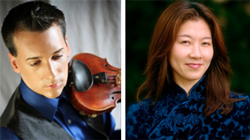by Timothy Robson

Both performers spent student years at the Cleveland Institute of Music but have subsequently developed international careers as soloists, chamber music collaborators, and, in the case of Ms. Izumida, teacher. Both continue to play regularly in Northeast Ohio.
The concert opened with a transcription of Après un rêve, one of Gabriel Fauré’s most famous songs. One of a set of Trois melodies, op. 7, published in 1878, the original French text recalls a lover’s out-of-body experience while dreaming. Upon awakening, the lover longs for the return of night and the beauty of dreams. The tune is wide-ranging, building to an emotional climax. Andrew Sords brought a full, rich sound to the piece, building tension to the climactic moment, then fading away to the quiet final cadence.
The rest of the program spent much of its time in the key of A major, with both Fauré’s Sonata No. 1 in A Major, Op. 13, and César Franck’s Sonata in A Major (1886). For listeners only familiar with the delicacy of Fauré’s songs and his Requiem, the violin and piano sonata might startle as a surprisingly robust piece. Throughout its four movements, the piano serves in many ways as the virtuoso underpinning of the sonata. The solo violin is generally given long, lyrical phrases of great melodic appeal. Indeed, Andrew Sords paid tribute to Eriko Izumida in his spoken remarks, saying that it is a piece for violin and “piano, 17 fingers.” The two worked as a team to project Fauré’s drama.
The second movement Andante was especially alluring. Over its gently rocking long-short-long-short rhythm, the violin and piano traded off the tune. The third movement is based on ascending 16th-note scalar passages, with a quirky repeated note in the middle of each scale. The tempo was quite brisk, and Izumida had some difficulty in articulating those repeated notes at the chosen tempo. At the end of the fourth movement the performers let loose with a torrent of fortissimo passagework. The loud sound was almost oppressive in the relatively small sanctuary of the Valley Lutheran Church.
Maurice Ravel’s great violin showpiece Tzigane closed the first half of the program. Originally for violin and piano (for which the composer called for an odd attachment called a luthéal, allowing the pianist to pull a lever to enable the piano to sound like cimbalom), Ravel later orchestrated the piano accompaniment. The French word tzigane means gypsy, and the work is a tribute to the 1920s French vogue for Hungarian gypsy exoticism. Tzigane opens with a long, unaccompanied violin solo of considerable virtuosity. When the piano enters, it is with a cascade of sparkling arpeggios. Here, the focus was on the violin, with its extremes of range, double-stops, and harmonics. Andrew Sords gave a heroic performance, powerful and in control of the many notes. In spoken notes before the performance, Sords identified the cultural influence of the piece as Spanish, but there could be no mistaking its gypsy violin style and Hungarian harmonic and melodic characteristics.
The second half of the program was devoted to a passionate performance of César Franck’s late masterpiece, the 1886 Sonata in A major. All of the composer’s musical trademarks are present: purely diatonic music interspersed with passages of great chromaticism; the use of canon; and so-called “cyclic” composition in which the same melodic theme recurs throughout the movements of the sonata. For this listener, the Franck was the best performance on the program. Both players seemed more comfortable in their collaboration, and the music had a beautiful ebb and flow, with gracefully molded phrases. The playing was sensitive, avoiding any attempt to overwhelm Franck’s music.
At the end, there was an encore, that popular (and lovely) warhorse, the “Méditation” from Jules Massenet’s opera Thaïs, which has retained its attraction ever since its 1894 Paris premiere. The audience undoubtedly went away happy, with a tune to hum on their drive home.
Published on ClevelandClassical.com November 5, 2015.
Click here for a printable copy of this article



